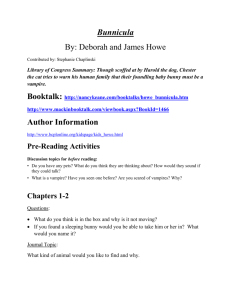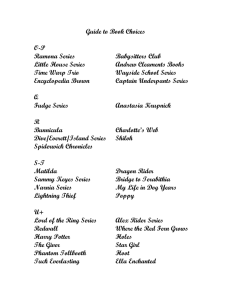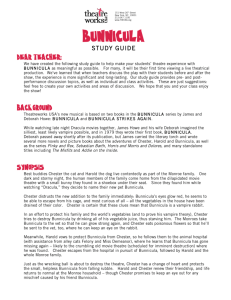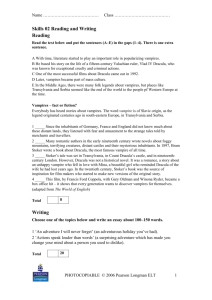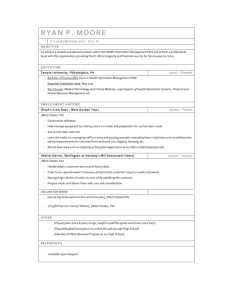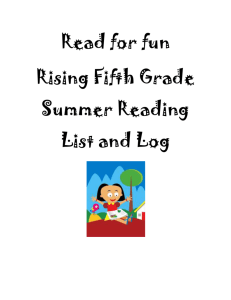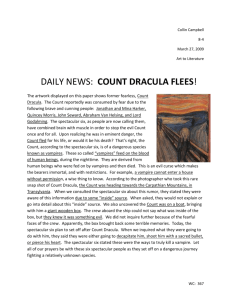Bunnicula Study Guide - Lone Tree Arts Center
advertisement
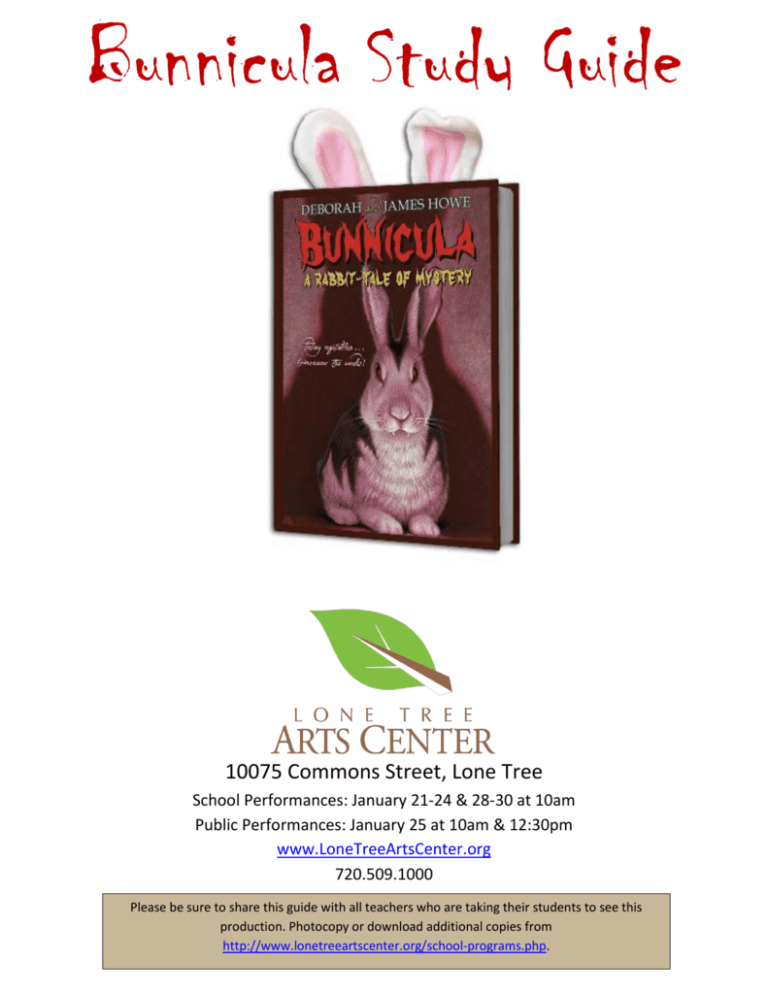
Bunnicula Study Guide 10075 Commons Street, Lone Tree School Performances: January 21-24 & 28-30 at 10am Public Performances: January 25 at 10am & 12:30pm www.LoneTreeArtsCenter.org 720.509.1000 Please be sure to share this guide with all teachers who are taking their students to see this production. Photocopy or download additional copies from http://www.lonetreeartscenter.org/school-programs.php. A Note to Teachers and Parents Dear Teachers and Parents, Bunnicula is a play with music adapted from the book: Bunnicula: A Rabbit-Tale of Mystery. The themes of the play include family, friendship, prejudice, peer pressure, and mystery. This delightful and poignant story, told from the perspective of the Monroe family’s household pets, is certain to entertain and educate students and their families. We have created the following study guide to help make your students’ theatre experience with BUNNICULA as meaningful as possible. For many, it will be their first time viewing a live theatrical production. We’ve learned that when teachers discuss the play with their students before and after the show, the experience is more significant and long-lasting. Our study guide provides pre- and post-performance discussion topics, as well as individual and class activities. These are just suggestions: feel free to create your own activities and areas of discussion. We hope that you and your class enjoy the show! About the Author Lone Tree Art Center’s production is based on books in the BUNNICULA series by James and Deborah Howe: Bunnicula and Bunnicula: A Rabbit-Tale of Mystery. While watching late night Dracula movies together, James Howe and his wife Deborah imagined the silliest, least likely vampire possible, and in 1979 they wrote their first book, BUNNICULA. Deborah passed away shortly after its publication, but James carried the literary torch and wrote several more novels and picture books about the adventures of Chester, Harold and Bunnicula, as well as the series Pinky and Rex, Sebastian Barth, Horris and Morris and Dolores, and many standalone titles including The Misfits and Addie on the Inside. Setting the Stage – Preparing for the Play Review theater etiquette in advance of the show. A good audience is integral to the performance – laughter, tears, applause are all wonderful and appropriate responses to a show and we want your students to be spontaneous. Inappropriate behavior can affect the whole audience and the performers. Please remind students, teachers and chaperones to turn off all cell phones, pagers, watch alarms and any other electronic devices before entering the theater. Food, gum, beverages, notebooks, backpacks, etc. are not allowed in the theater. We encourage groups to stay for an informative Q & A sessions with members of the cast. Due to space limitations the Lone Tree Arts Center is unable to accommodate large groups for indoor or outdoor lunch. We recommend utilizing nearby Belevedere Park and Prairie Sky Park. Inside the Guide About the Author ………. 2 Synopsis ………. 3 Pre-Show Discussion ………. 4 History & Geography Who is Dracula? ………. 5 Does Transylvania Exist? ………6 Science Pet Health ………. 7 Pet Behavior & Observation ………. 8 Veggie Match-Ups ………. 9 Nutrition .......... 10 Social Studies Friendships ………. 11 What Are You Afraid Of? ………. 12 Language Arts Playing With Words ………. 13 What’s In a Word? ………. 14 What Do You Mean? ………. 15 Writing ………. 16 Math What Time Is It? ………. 17 Answer Key ………. 18, 19 Bunnicula Study Guide 2 Synopsis Best buddies Chester the cat and Harold the dog live contentedly as part of the Monroe family. One dark and stormy night, the human members of the familyRobert, Ann, Pete, and Toby- come home from the movie theatre with a small bunny they found in a shoebox under their seat. Since they found him while watching “Dracula,” they decide to name their new pet Bunnicula. Chester, a keenly observant cat, quickly notices there is something strange about the rabbit: pointy fangs, black-and-white colored fur resembling a cape, nocturnal habits, and most of all – all the vegetables in the house have been drained of their color. Chester is certain that these clues mean that Bunnicula is a vampire rabbit. During the night patrol, Chester witnesses Bunnicula disappearing from his cage and then suddenly reappearing again, and they cannot understand why or how. The next day, the family discovers a white tomato in the kitchen-sucked dry and colorless. Chester believes he knows the cause of the fantastic phenomenon. No doubt about it-Bunnicula is a vampire! Chester becomes distraught, and he fears for the safety of his family. He warns Harold about the dreadful situation and asks Harold to join the patrol. The following day, more white vegetables are found. Realizing how serious the situation is, Chester tries to make his concerns known to the Monroes. First, Chester attempts to mimic a vampire in front of the Monroes, using Mr. Monroe’s towel as a cape and biting Harold in his neck. Second, Chester scatters garlic all over the house hoping to render the “vampire bunny” immobile. Finally, he tries to kill Bunnicula, but mistakenly tries using Mrs. Monore’s dinner steak to kill him—rather than a sharp stake, as indicated in the book, Dracula. Of course, these obscure behaviors are completely misunderstood by the family, and Chester is punished for his bad behavior by being forced to spend the night outside. Chester warns Harold about his vampire theory: “Today, vegetables. Tomorrow… the world!” Harold is extremely scared by Chester’s theory. In an attempt to warn Pete and Toby about Bunnicula, Harold destroys and ruins the boys’ play-time. Harold is scolded and, for the first time in his entire life, is called a “Bad Dog.” Maybe Chester’s imagination really was getting the better of him. Harold decides to quit listening to anything Chester says about Bunnicula, and chooses to befriend Bunnicula instead. Without his ally, Chester comes up with a new plan to prevent Bunnicula from changing the vegetables white: guard the kitchen every night. This seems to work, and soon Bunnicula becomes incredibly sick. Harold notices this, and he gets into a huge fight with Chester, knowing it is Chester who is preventing Bunnicula from eating. The Monroes are alarmed by their pets’ sudden strange behavior, so they decide to bring all of the pets to the vet for a check-up. The vet immediately diagnoses Bunnicula as suffering from extreme dehydration and instantly puts him on a diet of vegetable juice, which solves the entire situation of Bunnicula’s strange behavior! Chester is diagnosed as emotionally overwrought, a case of sibling rivalry with Bunnicula, and is given the name of a good cat psychiatrist. Singing and dancing their way through this hilarious musical mystery, the Monroes, and their fine furry friends, learn to make room in their hearts, and their home, for this most unusual bunny. This brings an end to Harold’s story. Bunnicula Study Guide 3 Pre-Show Discussion 1. Have you ever read the book Bunnicula? What do you remember from the book? 2. Do you have any pets? If so, what kind of pets do you have? What makes your pet special? If you do not have a pet, what kind of pet would you like to have? Why do you think this animal would make a good pet? 3. What kind of food does your pet, or the pet you would like to have, eat? Bunnicula is a bunny rabbit. What kids of food do you think he should eat? 4. Dracula is a novel by an Irish author Bram Stoker, and it is also the name of the worlds’ most famous vampire character. What do you know about Dracula? What do you know about vampires? What do they like and dislike? How can you get rid of them? 5. How would you feel if someone judged you according to what you looked like, without first getting to know you? How would you try to change their perception? Is it easy or difficult? Why? 6. Have you ever been in a situation where you were a new person being introduced to a group? How did it feel? How were you able to make new friends? Bunnicula Study Guide 4 History & Geography Dracula…Vampire…Bunnicula?!? Due to Chester’s obsession with horror tales and his insistence that the bunny the Monroes bring home is a blood-sucking monster, Bunnicula is chock-full of reference to vampires and methods for vanquishing them. Discuss the following with your students: Who is Dracula? Dracula is the central character in the novel Dracula, by Irish author Bram Stoker, written in 1897. Stoker was inspired by reading the accounts of Vlad Tepes, or Vlad the Impaler, a Romanian count from the 1400s. Vlad’s father belonged to the secretive group Order of the Dragon (or Dracul, in Romanian). Tepes, being the son of a Dracul, was titled Vlad Dracula. Historical reports of Vlad depict him as a terrible, cruel man who, by some accounts, killed tens of thousands of people during his lifetime. For hundreds of years it was said that Vlad Tepes was a vampire, but it was Stoker who created the foundation of the Dracula we know today. Dracula is depicted as a tall, old man wearing black, with a long white moustache and two pointy sharp teeth that stick out from his mouth, over his bottom lip. Since Stoker’s book was written, dozens of Hollywood movies and television shows based on Dracula, or inspired by its depiction of vampires, have generated. These movies and shows have changed the popular ideas of what a vampire is. Notably the most influential Dracula film was the 1931 movie Dracula, starring Hungarian actor Bela Lugosi. Lugosi’s dialect – “I vant to suck your bluhd” and physical representation of Dracula, complete with slicked-back black hair and a receding hairline, inspired the Halloween costume-version of vampires today. What is a vampire? We usually think of a vampire as Bram Stoker’s character Dracula and the movies, plays and television that has created many fun Dracula characters such as the The Count on Sesame Street, or Count Chocula, of cereal fame. How do you ward off vampires? Common vampire traits: Vampires are undead humans who roam the earth; Vampires have two pointy teeth; Vampires wear formal evening wear – like a black suit; Vampires sleep during the day and come out at night; Vampires can turn into bats; Vampires cannot see their reflection in the mirror; Vampires live in castles. Vampires do not like garlic, so wearing a string of garlic bulbs can ward off vampires. Vampires cannot stand the sight of a religious cross, so holding a cross will send a vampire running. Vampires can be destroyed with a wooden stake. Vampires cannot stand sunlight and can be harmed by its rays. Bunnicula Study Guide 5 Does Transylvania Exist? When Bunnicula is found, there is a note with him written in a rare language from the region of the Carpathian mountains, or Transylvania. Is there really a Transylvania, and if so, where can it be found? Find out more about Transylvania by performing classroom research and answering questions below. 1. Where is Transylvania located? 2. Name the countries adjacent to this region? 3. What is the climate in Transylvania? 4. List four major geographical features found in this region. 5. List four natural resources found in this region. 6. What language is spoken in Transylvania? 7. Label the region of Transylvania on the map of Romania below. Write in the names of geographical features and show the location of the region’s largest city. 8. How does your knowledge of Transylvania change your ideas about Bunnicula? 9. Why do you think the author of Dracula chose Transylvania as a setting for his story? Bunnicula Study Guide 6 Science Pet Health In the story, Bunnicula, Harold constantly mentions his desire for chocolate and other junk foods. Not only is this not a nutritious diet, the fact is that too much chocolate can be poisonous for dogs, while cats, unlike Chester, should not be given milk. Research the following questions to find out more facts about various pet diet. Fill in your answers in the animals below to the following questions: 1. What foods are appropriate for each animal? 2. How much should each animal be fed? 3. How often should each animal be fed? 4. What foods should be avoided? 5. What liquids and in what quantity should each animal be given? Foods to avoid for dogs & cats: Baby food Macadamia nuts Raw egg Bacon Chocolate Milk, cheese and dairy Moldy or spoiled food Raw fish Salt Do not feed your cat: Canned tuna! Caffeine Mushrooms Yeast dough Grapes and Raisins Onion and garlic Bunnicula Study Guide 7 Pet Behavior Pets are similar in that they must be taken care of and that they provide enjoyment. Yet, they are also very different in the ways in which they act. Think about a time when you observed cats, dogs, rabbits, and fish. Try to recall how each pet behaved. Choose two pets you best remember and answer the questions about their behaviors. 1. What activities did each pet enjoy doing? 2. What behaviors had each pet been trained to perform, if any? 3. What behaviors come naturally to each pet? 4. How are these two pets alike? 5. How are these two pets different? 6. Which type of pet do you prefer and why? Pet Observation Scientists gather information about animals by observing their behavior. Carefully observe a pet, either yours or one belonging to a friend, neighbor, or relative. Watch the pet for several minutes and write down what you see, then include your theory, or guess, about why the pet behaved as it did. Type of pet: Date: Place: Time: Behavior Observed: Theory: Bunnicula Study Guide 8 Veggie Match-Up What do these vegetables have in common? Give up? They are all mentioned in Bunnicula and some are even part of the plot! Although you have probably heard of or even eaten most of these veggies, some you may not recognize. Try matching each vegetable with its correct description below. 1. Arugula a. These contain more sugar than any other vegetable, except beets. ______ b. Also called “rocket,” this is a leafy relative of cabbage and broccoli. ______ c. Serve it steamed, fried, sautéed, grilled, stuffed or baked into bread or muffins. ______ 2. Bok Choy 3. Carrots 4. Celery 5. Cucumbers 6. Endive d. Its Chinese name literally means “white vegetable” – how appropriate! ______ 7. Garlic 8. Lettuce e. Every part of this is edible – leaves, roots, stems and seeds. ______ 9. Onions 10. Parsnip f. The botanical name of this juicy fruit means “wolf-peach.” ______ 11. Tomato 12. Zucchini g. These are loved by pigs, horses, and cattle (as well as some people). ______ h. California is the leading U.S. producer of this popular favorite. ______ i. Better have a hankie handy when cutting into these smelly things. ______ j. These were first brought to America by Columbus, who was “cool as a…”. ______ k. Other names for this prickly leaf are chicory, escarole, and witloof. ______ l. Gilroy, CA is the “Capital of the World” as far as lovers of this are concerned. ______ Bunnicula Study Guide 9 Nutrition Members of the Monroe household have their own particular likes and dislikes when it comes to food. Of course, some foods are more nutritious than others. A peanut butter sandwich contains protein, but a green sourball basically contains only sugar. A balanced diet contains a variety of foods needed for the body to function and even allows for occasional treats. The U.S. Department of Agriculture revised the dietary guidelines for good nutrition in 1992. A pyramid shape was chosen to show that carbohydrates (bread, cereal, rice and pasta) form the basis of a good diet, with other foods shown in decreasing, but necessary, quantities. In a small group of three to four students, create a balanced diet for a day by following the food pyramid guidelines. Once you have your day planned, write the items in the pyramid below. Be sure to include healthy snacks to round out meals. Bunnicula Study Guide 10 Social Studies Friendships Even though Chester and Harold are best friends, that doesn’t mean they don’t fight. Consider what happens in Bunnicula and answer the following questions: What are traits of friendship? Have you ever fought with your best friend? What happened? How did you make up with your friend? Why is it important to make up after having a fight with a friend or family member? If you were Harold, how would you react to Chester’s suspicions about Bunnicula? What would you do if your best friend asked you to do something that you did not agree with, or that you thought was wrong? What is the benefit of making new friends? What is the benefit of keeping old friends? Has making new friends ever affected your relationship with your old friends? In what ways? Bunnicula Study Guide 11 What are you afraid of? Everyone has experienced fear of people, places or things. Sometimes real events occur which scare us, such as a noise outside the house made by a lurking animal. Sometimes, though, our fears are imagined; for example, a noise outside turns out to be a branch being rubbed against a window by the wind. Think of times when you have experienced fear, one real and one imagined. Tell what caused the fear, when it occurred, and how you overcame it. Real Fear: Imagined Fear: Bunnicula Study Guide 12 Language Arts Playing with Words Bunnicula is full of clever language, word play, and interesting expressions. In the play, Chester tried to pound a STEAK into Bunnicula’s heart. Why was this funny? Because STEAK and STAKE are homophones – words that have the same sound but different spellings and meanings. With your class, brainstorm a list of homophones. Here’s a short list to get you started: • Ate/Eight • Bear/Bare • Board/Bored • Hear/Here • Peace/Piece • See/Sea • Sun/Son • Won/One • Would/Wood Have your students write sentences using both words. For example: Last night we ATE at EIGHT o’clock. You may also wish to give your students a short spelling quiz – be sure to use each word in a sentence! Bunnicula Study Guide 13 What’s in a Word? Bunnicula’s name was created by combining two words into one. Which two words are combined? The English language is always changing and evolving. Here are some words in the English language which were made by combining two words into one. These are called portmanteau words. See if you can figure out which two words are combined. Brunch Motel Spork Moped Infomercial Caplet For fun, make up your own new words by combining two existing words. Try combining two animals or two monsters to make up an original. Write a paragraph to describe your newly invented creature. My creature is: ___________________________________ Here is a little about my creature … Bunnicula Study Guide 14 What do you mean? In the play, characters used idioms – sayings that mean something different than the words they use, which can be confusing. One example: feeling “blue” is a saying which could describe someone who is actually blue in color, but more often than not, people who use it are really using it as an idiom meaning “to be sad”. See if you can figure out these idioms: “Time Flies” means ___________________________________________________________________ “Beats me” means ____________________________________________________________________ “Hogging the seat” means ______________________________________________________________ “Caught a cold” means _________________________________________________________________ “Don’t see eye to eye” means ___________________________________________________________ “Steal the spotlight” means _____________________________________________________________ “Get up on the wrong side of the bed” means ______________________________________________ “Take it easy” means __________________________________________________________________ “Hit the books” means _________________________________________________________________ “Get out of hand” means _______________________________________________________________ “Call it a day” means __________________________________________________________________ Bunnicula Study Guide 15 Writing Persuasive Writing Creative Writing During a majority of the play, Chester tries different methods of persuasion on Harold and the rest of the Monroe family to convince them that Bunnicula is a harmful vampire. Because the Monroes do not understand what Chester is trying to communicate, they all consider Chester’s warnings as merely silly or jealous behavior. If you were Chester and were given a chance to write a letter to the Monroes, how would you persuade them that Bunnicula is a vampire? Write your letter and give as many examples below. Bunnicula is a very special bunny. Because of Bunnicula’s unusual behaviors and his appetite, Chester suspects that he is a vampire. What if you discovered that your pet or one of your toys was really some sort of monster? Write about your adventure. Use an extra sheet if necessary. Bunnicula Study Guide 16 Math What time is it? Many people believe that dogs can tell time, not by using a clock but by using their memories. Dogs have been known to show up at their master’s door every day at the same hour, to return home to their master, just like Harold. Harold is not your ordinary dog however, he wants to learn how to use a clock and measure time. Please help him learn about time by solving the questions below: 1. The Monroes went to see Dracula at the movie theater. The film began at 5:50 p.m. and was over by 7:45 p.m. how long was the movie Dracula in minutes? 2. While defrosting the steak, Mrs. Monroe went to pick up Mr. Monroe at the college. It took Mrs. Monroe 47 minutes round trip. She left the home at 6:30 p.m. When did she get home? 3. How long did Bunnicula sleep if he went to bed at 9:40 a.m. and woke up at 7:20 p.m.? 4. The Monroes left home at 4:42 p.m. to drive to the pet store. The drive took them 23 minutes. What time did they arrive? 5. Harold played with Pete for 14 minutes, walked with Toby for 36 minutes and sat in the kitchen with Mrs. Monroe for 45 minutes. What was the total time that Harold spent that day with the Monroes? 6. It is now 10:45 a.m. Chester started to put garlic around the house 35 minutes ago. What time did he start his job? 7. Mrs. Monroe made homemade cupcakes. She began making them on Saturday morning at 8:29 a.m. She finished baking the cupcakes by 9:33 a.m. How long did it take her? 8. Harold and Chester were on night patrol from 9:45 p.m. to 5:55 a.m. How long was the night patrol? Bunnicula Study Guide 17 Answer Key Transylvania …. page 6 1. Transylvania is a region covering central and northwestern Romania. It includes most of Romania’s mountains, the Transylvanian plateau, and the northwest plains. 2. The countries adjacent to this region are Hungary, Yugoslavia, Bulgaria, the Ukraine, and Moldova. 3. Transylvania has hot, sunny summers and cold, cloudy winters. 4. The four major geographical regions could include plains, mountains, valleys, a plateau, and rivers. 5. Four natural resources could include iron, lead, lignite, manganese, natural gas, and sulfur. 6. Romanian is the official language. Veggie Match-Up …. page 9 a. b. c. d. e. f. g. h. i. j. k. l. 3) Carrots 1) Arugula 12) Zucchini 2) Bok Choy 4) Celery 11) Tomato 10) Parsnip 8) Lettuce 9) Onions 5) Cucumber 6) Endive 7) Garlic What’s in a word? …. page 14 Brunch: breakfast and lunch Motel: motor and hotel Spork: spoon and fork Moped: motor and pedal Infomercial: information and commercial Caplet: capsule and tablet What do you mean? …. page 15 “Time Flies” – Time is going by fast “Beats me” – Don’t know “Hogging the seat” – Hogs or Pigs are known for eating a lot; this refers to taking a lot of the seat “Caught a cold” – Got sick “Don’t see eye to eye” – Do not agree “Steal the spotlight” – To be the center of attention “Get up on the wrong side of the bed” – To be in a bad mood from the start of the day for no particular reason “Take it easy” – To be calm and don’t get angry or to say good bye “Hit the books” – To study hard Bunnicula Study Guide 18 “Get out of hand” – To lose control of a situation “Call it a day” – To stop the work you are doing What time is it? …. page 17 1. 2. 3. 4. 5. 6. 7. 8. 115 minutes 7:17 p.m. 9 hours and 40 minutes 5:05 p.m. 1 hour and 35 minutes 10:10 a.m. 1 hour and 4 minutes 8 hours and 10 minutes Bunnicula Study Guide 19

